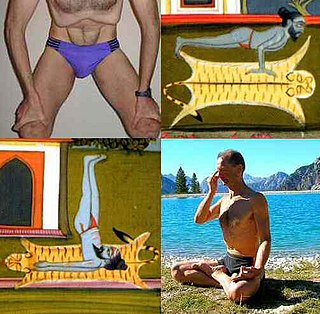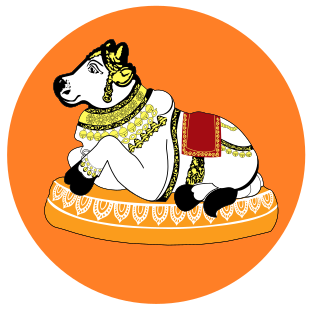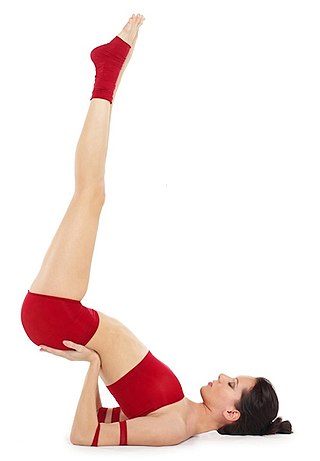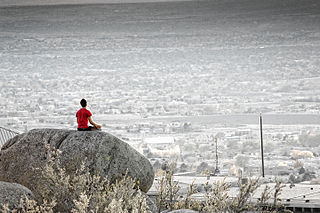Related Research Articles

Hatha yoga is a branch of yoga that uses physical techniques to try to preserve and channel vital force or energy. The Sanskrit word हठ haṭha literally means "force", alluding to a system of physical techniques. Some hatha yoga style techniques can be traced back at least to the 1st-century CE, in texts such as the Hindu Sanskrit epics and Buddhism's Pali canon. The oldest dated text so far found to describe hatha yoga, the 11th-century Amṛtasiddhi, comes from a tantric Buddhist milieu. The oldest texts to use the terminology of hatha are also Vajrayana Buddhist. Hindu hatha yoga texts appear from the 11th century onward.
Niyamas are positive duties or observances. In Dharma, particularly Yoga, niyamas and their complement, yamas, are recommended activities and habits for healthy living, spiritual enlightenment, and a liberated state of existence. It has multiple meanings depending on context in Hinduism. In Buddhism, the term extends to the determinations of nature, as in the Buddhist niyama dhammas.
In Sanskrit texts, Rāja yoga was both the goal of yoga and a method to attain it. The term also became a modern name for the practice of yoga in the 19th-century when Swami Vivekananda gave his interpretation of the Yoga Sutras of Patanjali in his book Raja Yoga. Since then, Rāja yoga has variously been called aṣṭāṅga yoga, royal yoga, royal union, sahaja marg, and classical yoga.

Natha, also called Nath, are a Shaiva sub-tradition within Hinduism in India and Nepal. A medieval movement, it combined ideas from Buddhism, Shaivism and Yoga traditions of the Indian subcontinent. The Naths have been a confederation of devotees who consider Shiva as their first lord or guru, with varying lists of additional gurus. Of these, the 9th or 10th century Matsyendranatha and the ideas and organization mainly developed by Gorakhnath are particularly important. Gorakhnath is considered the originator of the Nath Panth.

Hammiradeva was the last ruler from the Ranthambore branch of the Chauhans (Chahamanas). He is also known as Hamir Dev Chauhan in the Muslim chronicles and the vernacular literature.

Gheranda Samhita is a Sanskrit text of Yoga in Hinduism. It is one of the three classic texts of hatha yoga, and one of the most encyclopedic treatises in yoga. Fourteen manuscripts of the text are known, which were discovered in a region stretching from Bengal to Rajasthan. The first critical edition was published in 1933 by Adyar Library, and the second critical edition was published in 1978 by Digambarji and Ghote. Some of the Sanskrit manuscripts contain ungrammatical and incoherent verses, and some cite older Sanskrit texts.

Gorakhnath was a Hindu yogi, mahasiddha and saint who was the founder of the Nath Hindu monastic movement in India. He is considered one of the two disciples of Matsyendranath. His followers are known as Jogi, Gorakhnathi, Darshani or Kanphata.

Viparita Karani or legs up the wall pose is both an asana and a mudra in hatha yoga. In modern yoga as exercise, it is commonly a fully supported pose using a wall and sometimes a pile of blankets, where it is considered a restful practice. As a mudra it was practised using any preferred inversion, such as a headstand or shoulderstand. The purpose of the mudra was to reverse the downward flow of vital fluid being lost from the head, using gravity.
Shiva Samhita is a Sanskrit text on yoga, written by an unknown author. The text is addressed by the Hindu ascetic Shiva to his consort Parvati. The text consists of five chapters, with the first chapter a treatise that summarizes nondual Vedanta philosophy with influences from the Sri Vidya school of South India. The remaining chapters discuss yoga, the importance of a guru (teacher) to a student, various asanas, mudras and tantra.

Kurmasana, Tortoise Pose, or Turtle Pose is a sitting forward bending asana in hatha yoga and modern yoga as exercise.
A subhashita is a literary genre of Sanskrit epigrammatic poems and their message is an aphorism, maxim, advice, fact, truth, lesson or riddle. Su in Sanskrit means good; bhashita means spoken; which together literally means well spoken or eloquent saying.

The Dhyanabindu Upanishad is an ancient Sanskrit text and a minor Upanishad of Hinduism. It is one of twenty Yoga Upanishads in the four Vedas.

The Yogashikha Upanishad is a Sanskrit text and one of the minor Upanishads of Hinduism. It is one of twenty Yoga Upanishads in the four Vedas.

Sir James Mallinson, 5th Baronet, of Walthamstow is a British Indologist, writer and translator. He is Boden Professor of Sanskrit at the University of Oxford, and recognised as one of the world's leading experts on the history of medieval Hatha yoga.
Govinda-bhaṭṭa, known by his pen name Akbariya Kālidāsa, was a 16th-century Sanskrit-language court poet from present-day India. His patrons included Rewa's ruler Ramachandra and the Mughal emperor Akbar.
Akāla-jalada was a Sanskrit-language poet from the Tripuri Kalachuri kingdom of present-day Central India. He was the great-grandfather of the Gurjara-Pratihara court poet Rajashekhara.
Achala-simha was a Sanskrit-language poet from India, who lived in the 12th century or earlier. His verses appear in several anthologies of Sanskrit poems.

Gorakshasana is a seated asana in hatha yoga. It has been used for meditation and in tantric practice.

The Amaraugha and the Amaraugha Prabodha are recensions of a 12th century Sanskrit text on haṭha yoga, attributed to Gorakṣanātha. The Amaraugha Prabodha is the later recension, with the addition of verses from other texts and assorted other materials. The text's physical practices imply a Buddhist origin for haṭha yoga.
References
- ↑ Damon Zacharias Lycourinos 2012, p. 190.
- 1 2 3 4 Ludwik Sternbach 1974, p. 17.
- ↑ K. R. Srikanthamurthy 2005, pp. 100–111.
- 1 2 3 Ludwik Sternbach 1974, p. 18.
- ↑ James Mallinson 2011, p. 772.
Sources
- Damon Zacharias Lycourinos (2012). Occult Traditions. Numen Books. ISBN 978-0-9871581-3-0.
- James Mallinson (2011). Knut A. Jacobsen; et al. (eds.). Haṭha Yoga in the Brill Encyclopedia of Hinduism, Vol. 3. Brill Academic. pp. 770–781. ISBN 978-90-04-27128-9.
- K. R. Srikanthamurthy (2005). Biographical History of Indian Medicine: Pictorial. Chaukhambha Orientalia.
- Ludwik Sternbach (1974). Subhasita, Gnomic and Didactic Literature. Otto Harrassowitz Verlag. ISBN 978-3-447-01546-2.
- Theodor Aufrecht (1873). Ueber die Paddhati von Çârñgadhara (PDF).
